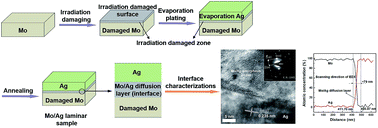Induction of diffusion and construction of metallurgical interfaces directly between immiscible Mo and Ag by irradiation-induced point defects
Abstract
As advanced materials, Mo/Ag laminated metal composites (LMCs) can be used for the interconnectors of spacecraft solar arrays and extend spacecraft orbital lifetime effectively. However, since diffusion alloying is very difficult in immiscible Mo–Ag systems, the preparation of Mo/Ag LMCs with metallurgical bonding interfaces is very difficult. To solve the problem, irradiation-induced point defects (IIPDs) are used to induce diffusion and realize alloying in an immiscible Mo–Ag system in this research. The induction process includes: first, causing IIPDs on the surface of a Mo sheet through ion implantation; secondly, evaporating an Ag layer onto the ion implantation damaged Mo sheet to obtain a Mo/Ag laminated sample; and lastly, annealing treatment for the sample. The measurements adopted in this paper primarily include high-resolution transmission electron microscopy (HRTEM) and variable energy positron annihilation spectroscopy (VEPAS). The microstructure analysis for the Mo/Ag interface proves that the Ag elements diffuse into Mo during the final annealing. The micro-test results also reveal that, along with the diffusion of Ag elements, the IIPDs migrate in the opposite direction from Mo to Ag with a migration distance of ∼77 nm, which agrees well with the diffusion distance of Ag elements (∼79 nm). The calculation results of the diffusion energy barrier (Ea) show that the migrating IIPDs are vacancies. So it can be concluded that IIPDs, especially vacancies, can indeed induce diffusion in an immiscible system, and the diffusion mechanism is most likely the vacancy-assisted mechanism. The Kirkendall voids found in the samples verify the judgment on the diffusion mechanism. Through the induction of diffusion, a metallurgical interface is successfully constructed between immiscible Mo and Ag without using any metal interlayer, indicating that the Mo/Ag LMCs can be prepared by this novel method.



 Please wait while we load your content...
Please wait while we load your content...